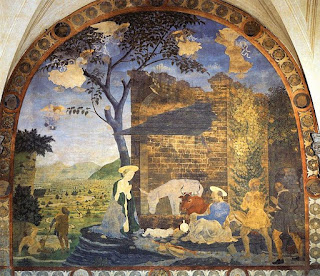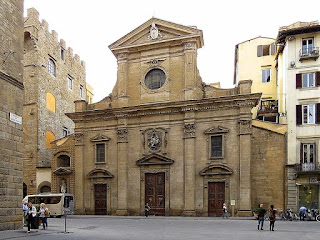One of first to paint realistic landscapes
 |
| A self-portrait of Alesso Baldovinetti from a fragment of damaged fresco, now in the Accademia Carrara in Bergamo |
Baldovinetti was among a group described as scientific realists and naturalists in art which included Andrea del Castagno, Paolo Uccello and Domenico Veneziano. Influenced by Uccello’s use of visual perspective, he had a particular eye for detail and his views of the Arno river in his Nativity and Madonna are regarded as among Europe’s earliest paintings of accurately reproduced landscapes.
Veneziano’s influence is reflected in the pervasive light of his earliest surviving works, and he was also greatly influenced by Fra Angelico. Historians believe that in the 1460s Baldovinetti was the finest painter in Florence, although some argue that he did not fulfil all his initial promise.
Born into the family of a wealthy Florentine merchant, Baldovinetti rejected the chance to follow his father’s trade in favour of art.
 |
| Baldovinetti's Nativity in the Basilica of Santissimi Annunziata in Florence with the Arno river in the background |
Apart from his frescoes in the Annunziata basilica in Florence, other surviving works include those done for the chapel decorations in the Basilica of San Miniato al Monte, also in his home city. It is regrettable that he did not help some of his work by using a mixture of yolk of egg and liquid varnish - his own invention - to protect his paintings from damp, but which in the event caused them to deteriorate more quickly.
Baldovinetti worked on several pieces for the church of Santa Trinita, where he painted an altarpiece of the Virgin Mary and child with the saints Gualberto and Benedetto, which is now in the Academy of Florence.
 |
| Baldovinetti's Annunziation |
Two of his works are in the Uffizi Gallery, including an Annunciation and Madonna and Child with Saints. The National Gallery in London has a Portrait of a Lady in Yellow that for centuries was wrongly attributed to Piero della Francesca, while there is a Madonna and Child in the Louvre in Paris.
Among Baldovinetti’s own pupils was Domenico Ghirlandaio, who went on to become a major figure in the so-called "third generation" of the Florentine Renaissance, a contemporary of Verrocchio and Sandro Botticelli.
Baldovinetti died in August 1499 at the age of 73 and was buried in the Basilica of San Lorenzo.
 |
| The facade of the Basilica della Santissima Annunziata in the San Marco district of Florence |
The Basilica della Santissima Annunziata is in the Piazza della Santissima Annunziata in the San Marco district of Florence. The church was founded in 1250 and rebuilt by Michelozzo between 1444 and 1481. Frescoes by Andrea del Sarto can be seen in the atrium of the church. Newly wed couples traditionally visit the church to present a bouquet of flowers to a painting of the Virgin by a 13th century monk, where they pray for a long and fruitful marriage.
 |
| The church of Santa Trinita, where Balodovinetti worked on a number of pieces |
The church of Santa Trinita, which overlooks the square of the same name, can easily be reached by walking down the elegant Via de' Tornabuoni towards the Arno. Standing near the Santa Trinita bridge, it was founded in the middle of the 11th century. Originally built in a simple Romanesque style, it was later was enlarged and restored following Gothic lines. The church’s Sassetti Chapel contains 15th-century frescoes by Domenico Ghirlandaio.
More reading:
The humble friar who became one of the greatest artists of the 15th century
Why the talent of Sandro Botticelli was forgotten for four centuries
How Piero della Francesca applied geometry and maths to his work
Also on this day:
1628: The death of painter Palma Giovane
1963: The birth of singer Alessandro Safina
Home




